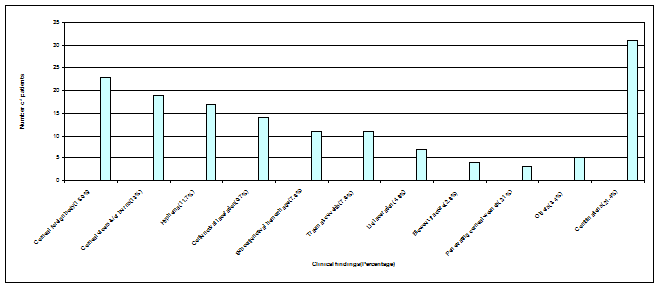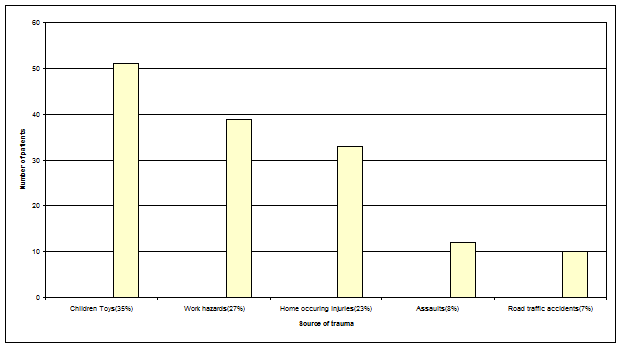Objectives: A retrospective, hospital-based study was conducted in Princess Haya Military Hospital. The aim was to evaluate the emergency eye cases during the feast vacation in Aqaba.
Methods:We chose four feast vacations during the years 2001 and 2002, counting 20 days, and compared the emergency cases during these days with those seen on other randomly chosen 20 days during these two years. The cause and type of ocular trauma were studied.
Results: One hundred seventy nine cases were treated. The traumatic to non-traumatic ratio was 4.3:1 and the traumatic cases had a pediatric to adult ratio of 1.8:1 vs. 1:3.9 in the non-traumatic cases. Males were significantly more involved than females. During the non-festive period, the total number of emergency cases was 56 cases; the traumatic to non-traumatic ratio was 1:1.3. The traumatic pediatric to adult cases ratio was 1:1.7 vs. 1:1.5 in the non-traumatic cases. During the festive period the largest group was adult male traumatic cases. The highest number of patients during the feast had corneal foreign body as a single problem. The highest number of admissions was due to hyphema. Children’s toys were at the top of the list as a source of traumatic eye emergencies; and the most common traumatic toy was the air-powered gun.
Conclusion: The emergency room and staff should be prepared for this increase in the number and the type of cases during the feast vacations. Community education concerning prevention of domestic injuries is needed.
Key words: Ophthalmic emergency, Eye trauma, Hyphema.
JRMS April 2007; 14(1): 30-33Introduction Holidays and feasts are fun and lead to routine change in routine daily schedule. This is reflected obviously on the cases presenting to the emergency room during these days.
Researchers hava studied the epidemiology of eye trauma in severed countries; few have studied the changing trends during holidays(1-3). Holiday related injuries have been tackled more in emergencies other than eye related, like head injuries(4) psychiatry(5), and fall-related injuries(6). Most noticeable were the increase in the number of cases as well as the male dominance.
The aim of this study was to analyze critically the possible causes of ocular trauma during feast holidays.
MethodsWe chose four feast vacations during the years 2001 and 2002, counting 20 days, and compared the emergency cases during these days with those seen on other randomly chosen 20 days during these two years. The age, sex, traumatic vs. non-traumatic cases and the type and source of trauma were studied.
Results
The total number of eye emergency cases during the festive period, was 179 cases. The traumatic cases were 145 making the ratio of traumatic to non-traumatic emergency cases during the feasts 4.3:1. During the non-festive days, the total number of eye emergency cases was 56. The number of traumatic cases was 24 and 32 cases were non-traumatic emergencies (Traumatic to non-traumatic ratio of 1:1.3 (Table I).
Pediatric to adult ratio of the traumatic emergency cases during the feast were 1.8:1, while that during the non-festive period was 1:1.7. During the feasts, overall male to female ratio was 13.5: 1. The ratio for pediatric age group was 16:1 and for the adults was 12:1. During the non-festive period the pediatric male to female ratio was 2:1, and 4:1 in adults’ age group. During the feast, the mean age in pediatric group was eight years and in adults was 26 years.
The non-traumatic emergencies during the feasts showed different ratios; the pediatric to adults’ ratio was 1: 3.9 compared to 1:1.5 during the non-festive period. The pediatric male to female ratio was 1.3:1 compared to 1:1.7 during the non-feast days. Adult male to female ratio was 1:1.1 compared to 1:1.4 during the non-feast days (Table II).
During the festive period, the total number of admission was 26 (14% of total cases). Twenty two were hyphema cases (85% of total), three cases of ruptured globes and one cases of orbital cellulite. Pediatric admissions were 81% of total admission. During the non-festive period, only two patients were admitted (5.4% of the total cases). Both were hyphema cases, one adult and one child (Table II).
DiscussionFew studies analyzed the cases encountered during holidays. Most noticed the difference in the number, type of cases as well as severity of cases during holidays. Our study shows a tripling of the number of cases encountered during the feast holidays in comparison with the non-festive days, with a traumatic to non-traumatic ratio of 4.3:1 in the former compared to 1:1.3 in the later.
Trauma in male children (<14 years) is the largest group. They outnumber the female cases in a ratio of 12:1 during festive periods. The mean age was 8 years. This ratio is 2:1 during the non-festive period. A study in Portugal had a similar male to female ratio of eye injury but resulting from modern sports (11:1), and the mean age was 27 years(7).
The commonest cases encountered were corneal foreign bodies and ulcers followed by hyphema and adnexal injuries. A recent study in the United States showed that the highest injury rate to the eye after trauma was adnexal injury and corneal foreign bodies(8).
The cause of an anterior chamber hemorrhage in contusion injuries is thought to be related to the posterior displacement of tissue or to the resultant fluid wave in the aqueous humor and the vitreous.
This sudden dynamic shift stretches the limbal vessels and displaces the iris and the lens. This displacement may result in a tear at the iris or the ciliary body, usually at the angle structures. A tear at the anterior aspect of the ciliary is the most common site of bleeding and occurs in about 71% of cases. The blood exits from the anterior chamber via the trabecular meshwork and the Schlemm canal or juxtacanalicular tissue.
The usual duration of an uncomplicated hyphema is five to six days. The mean duration of elevated intraocular pressure is six days. Secondary bleeding into the anterior chamber results in a markedly worse prognosis. It occurs in 7-38% of all patients with hyphema(9).
The commonest indication of hospital admissions was hyphema (85% of cases) during the festive period while only two cases admitted during the non-festive period were hyphema cases. Mean duration of admission was 4.1 days and mean age was eight years.
A study in Scotland showed that the admissions to hospital which are due to eye injury over one year were 65% due to blunt trauma, 60% were hyphema cases. The mean duration of admission was 4.2 days and age group of 5-14 years(10).
The commonest source of trauma during the festive period was due to children toys (35% of cases) followed by work hazards (27%). As most of the children-toy injuries occur at home or near by, these increases the home occurring injuries to more than 50% of the cases. We want to stress upon the hazards of some toys we put them into separate groups.
The commonest toy to injure the eye was the air soft gun. It was responsible for ~55% of hyphema admitted patients. Fortunately, no one had persistent increased intraocular pressure (patients with hyphema were followed for one year). Only four patients had angle recession and it was of 10-20 degrees only. These patients were shot from a short distance. No secondary hemorrhage post air-soft gun hyphema.
Air soft guns consist of a plastic pistol that shoots hard plastic bullets, with a diameter of 6.0 mm. These bullets are available in different weights (0.12, 0.2, 0.25g); all of which are much lighter than the lead bullets used in Ball bearing guns (0.52-1.6g). The guns use the direct force of a spring coil or compressed air to fire bullets. In an independent ballistic investigation, the calculated energy for bullets weighing 0.2 and 012 g was 0.363 and 0.347 J, respectively. This energy results in velocities of 61.5 and 74.9 m/s, respectively, and in-flight ranges of 30 to 50m, respectively.
The bullets are made of a very hard and non-compressible plastic material and thus, do not absorb energy(11). Although it is a desired toy by many boys, we do not prefer to call it a children’s toy. A case has been published last year describing the injury to the thoracic wall reaching deep to the subcutis by a soft-air pistol(12). Besides, we recommend if these guns are to be bought, to buy them with goggles, with parent’s approval and supervision.
According to the Prevent Blindness America Web site, more than 10,000 children younger than 14 were treated in emergency rooms for toy-related eye injuries in 2003 [13]. The prevalence of blindness in Jordan is 0.6%, according to the WHO Representation Office.
Conclusion
The emergency room and staff should be prepared for this increase in the number and the type of eye trauma cases during the feast vacations. Community education concerning prevention of domestic injuries is needed. Public health workers, ophthalmologists and parents should work hand in hand to encourage the authorities to apply strict standards on children toys manufactured, imported and sold, for the best interest of our children.
Table I: Clinical Analysis of Emergency Cases.
|
Parameters
|
Festive Days
|
Non-Festive Days
|
|
Number
|
Ratio
|
Number
|
Ratio
|
|
Traumatic
|
145
|
4.3:1
|
24
|
1:1.3
|
|
Non- Traumatic
|
34
|
32
|
Table II: Epidemiologic Analysis of Emergency Cases.
|
Parameters
|
Traumatic
|
Non-Traumatic
|
|
Festive
|
Non-festive
|
Festive
|
Non-festive
|
|
Children (m=8years):
Adults (m=26 years)
Ratio
|
1.8:1
|
1:1.7
|
1:3.9
|
1:1.5
|
|
Males: Females
Ratio
|
13.5:1
|
2:1
|
1.3:1
|
1:1.7
|
 Fig. 1:
Fig. 1: Chart of details of the emergency eye cases encountered during the festive period.
 Fig. 2:
Fig. 2: A chart of sources of eye trauma during the festive period.
References
1.
Serrano JC, Chalela P, Arias JD. Epidemiology of childhood ocular trauma in a northeastern colombia region. Arch Ophthalmol 2003; 121: 1439-1445.
2.
Joao A. Filipe C, Vitor L, et al. Soccer-related ocular injuries. Arch Ophthalmol 2003; 121: 687-694.
3.
Thompson CG, Kumar N, Billson FA, Martin F. The aetiology of perforating ocular injuries in children. Br J Ophthalmol 2002; 86(8): 920-922.
4.
Gilthorpe MS, Wilson RC, Moles DR, Bedis R. Variation in admissions to hospital for head injury and assault to the head. British Journal of Oral and Maxillofacial Surgery 1999; 37: 294-300.
5.
Halpern S, Doriaswamy P, Tupler L, et al. Emergency department patterns in Psychiatry visits during the holiday season. Ann Emerg Med 1994; 24(5): 939-943.
6.
Centers for Disease Control and Prevention. Fall-related injuries during the holiday season-United States. MMWR 2004/53(48); 1127-1129.
7.
Filipe JA, Rocha-Souse A, Falcao-Reis F, Castro-Correia J. Modern sports eye injuries. Br J Ophthalmol 2003; 87(11): 1336-1339.
8.
McGwin G, Owsley C. Rates of eye injury in the United States. Archives of Ophthalmology 2005; 123: 970-976.
9.
Shepperd J, Williams PB. Hyphema. E Medicine May 2, 2005.
10.
MacEwen CJ, Baines PS, Desai P. Eye injury in children: the current picture. Br J Ophthalmol 1999; 83: 933-936.
11.
Fleischhauer JC, Goldblum D, Frueh BE. Ocular Injuries caused by air soft guns. Arch Ophthalmol 1999; 117: 1437-1439.
12.
Nadjem H, Braunwarth R, Pollak S. Injury potential of soft-air pistols. Arch Kriminol 2004; 213(1-2): 15-21.
13.
Zimmerman F. Parents get warning about dangerous toys. Stars and Stripes 2004; 14.